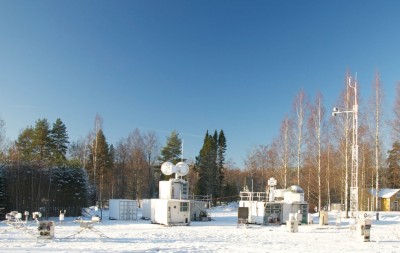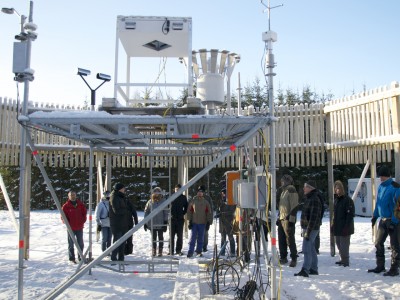Biogenic Aerosols Examined in Finland Forest
Published: 5 February 2014

Among the most active areas of biogenic aerosol production are boreal forests, like those found in Finland. As Earth experiences climate change differently in various parts of the world, researchers in Finland are investigating the effects of biogenic aerosols on cloud and precipitation processes, and ultimately, their effect on climate.
To help them explore these science questions, the ARM Climate Research Facility is deploying one of its mobile facilities among 50-year-old pine trees in southern Finland as part of the Biogenic Aerosols – Effects on Clouds and Climate field campaign. Equipped with dozens of different instruments to measure properties in the atmosphere, the second ARM Mobile Facility (AMF2) began operations this month and will continue obtaining continuous data through September 2014.
“The installation went very well and we enjoyed working with our Finnish counterparts,” said Nicki Hickmon, a meteorologist from Argonne National Laboratory and the site manager for the AMF2. “Our efforts were rewarded with a weather event on the first day of operations!”

In conjunction with the University of Helsinki’s Station for Measuring Ecosystem-Atmosphere Relations (SMEAR-II) in Hyytiälä, the surface-based data from the AMF2 will be augmented by additional measurements of aerosol properties from research aircraft and tower observations.
“The AMF2 gives us something that we have missed for a long time: continuous data over an extended period of the vertical profile and spatial data on aerosols, clouds, and precipitation around Hyytiälä,” said Tuukka Petäjä, a professor at the University of Helsinki and the principal investigator for the BAECC campaign. “This enables us to probe the aerosol-cloud-precipitation interactions and we can connect our long-term ground-based data to the processes occurring higher up, such as cloud formation.”
Like Hickmon, Petäjä also noted the arrival of the snow storm and measurements by the AMF2 as underlining the “reality” of the endeavor and an important step in his ongoing research.
“I’ve done enough measurements myself, so I know the difficulties they [the AMF2 and SMEAR-II teams] are facing. There is always something to be done and fixed,” he explained. “But I’m confident that the end result will be excellent and unprecedented in the boreal environment!”
Aerosols are an essential component of the Earth’s climate. They can reflect energy into space, cooling the atmosphere, or they can combine with clouds to create either warming or cooling effects. Using data from this study, scientists will investigate boreal forests as a source of aerosol particles that form and grow to become cloud droplets, and how they effect precipitation processes.
More photos of the AMF2 site are available in Flickr.
The ARM Climate Research Facility is a DOE Office of Science user facility. The ARM Facility is operated by nine DOE national laboratories, including .
Keep up with the Atmospheric Observer
Updates on ARM news, events, and opportunities delivered to your inbox
ARM User Profile
ARM welcomes users from all institutions and nations. A free ARM user account is needed to access ARM data.


















